Source: WTL© photograph of unsigned photo (1947) in Pierre Gauvreau; Passeur de modernité. Québec: Musée de la civilization, 2014, p. 31.
Image: Unsigned 1947 photograph of some of the future signers of the Refus global (1948) art manifesto. From the left: Jean Paul Riopelle, Muriel Guilbaut (background), Pierre Gauvreau, Madeleine Arbour, Jean-Paul Mousseau, and (standing) Claude Gauvreau. In all, sixteen people (9 men and 7 women) signed this manifesto.
Comments: This group of rebellious young Québécois artists published this manifesto, under the guidance of Paul-Émile Borduas (1905-1960), with the stated intention of transforming Québec society by refusing to submit to anything that curbed an individual's freedom (liberté) to think and be creative for himself or herself especially in social, political, and artistic terms. In other words, they were engaging in a "global" refusal to submit to traditionally received and socially enforced limits on their self-realization and self-expression. In this sense, they became the "unsubmissive" (les insoumis) by following the lead of the French Surralism of André Breton (1896-1966) and others, but without even submitting to the unintended tyranny of Surralism itself. Some of the signers of this "automatist" document waged a post-colonial campaign avant la lettre to forge a non-European, non-Anglo-American society (e.g., Claude Gauvreau), whereas others (e.g., Pierre Gauvreau) sought to join the world-wide modern arts movement by democritizing the arts in Québec with specifically urban and rural Québécois ethos and content. This text became a humanities point of reference for the 1960s socio-political autonomy moment in Québec known as the "Révolution tranquille" (Quiet Revolution).
Humanities Question: With the information you have in the comments above, analyze and evaluate this photograph as a humanities artifact.

